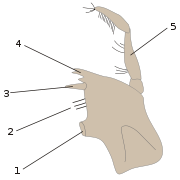
Peracarida
Encyclopedia
The superorder Peracarida is a large group of malacostraca
n crustacean
s, having members in marine, freshwater, and terrestrial habitats. They are chiefly defined by the presence of a brood pouch
, or marsupium, formed from thin flattened plates (oostegites) borne on the basalmost segments of the legs
Other characters which unite the group are the possession of a single pair of maxillipeds
(rarely 2–3), of mandibles with an articulated accessory process between the molar and incisor teeth in the adults (called the lacinia mobilis), and of a carapace
which is often reduced in size and is not fused with the posterior thoracic somites. The young hatch at a post-larval, prejuvenile stage called a manca which lacks the last pair of legs.
 The following orders are included:
The following orders are included:
Malacostraca
Malacostraca is the largest of the six classes of crustaceans, containing over 25,000 extant species, divided among 16 orders. Its members display a greater diversity of body forms than any other class of animals, and include crabs, lobsters, shrimp, krill, woodlice, scuds , mantis shrimp and many...
n crustacean
Crustacean
Crustaceans form a very large group of arthropods, usually treated as a subphylum, which includes such familiar animals as crabs, lobsters, crayfish, shrimp, krill and barnacles. The 50,000 described species range in size from Stygotantulus stocki at , to the Japanese spider crab with a leg span...
s, having members in marine, freshwater, and terrestrial habitats. They are chiefly defined by the presence of a brood pouch
Brood pouch (Peracarida)
The marsupium or brood pouch, is a characteristic feature of Peracarida, including the orders Amphipoda, Isopoda and Cumacea. It is an egg chamber formed by oostegites, which are appendices which are attached to the coxae of the first pereiopods...
, or marsupium, formed from thin flattened plates (oostegites) borne on the basalmost segments of the legs
Arthropod leg
The arthropod leg is a form of jointed appendage of arthropods, usually used for walking. Many of the terms used for arthropod leg segments are of Latin origin, and may be confused with terms for bones: coxa , trochanter , femur, tibia, tarsus, ischium, metatarsus, carpus, dactylus ,...
Other characters which unite the group are the possession of a single pair of maxillipeds
Decapod anatomy
The decapod crustacean, such as a crab, lobster, shrimp or prawn, is made up of nineteen body segments grouped into two main body parts, the cephalothorax and the abdomen. Each segment may possess one pair of appendages, although in various groups these may be reduced or missing...
(rarely 2–3), of mandibles with an articulated accessory process between the molar and incisor teeth in the adults (called the lacinia mobilis), and of a carapace
Carapace
A carapace is a dorsal section of the exoskeleton or shell in a number of animal groups, including arthropods such as crustaceans and arachnids, as well as vertebrates such as turtles and tortoises. In turtles and tortoises, the underside is called the plastron.-Crustaceans:In crustaceans, the...
which is often reduced in size and is not fused with the posterior thoracic somites. The young hatch at a post-larval, prejuvenile stage called a manca which lacks the last pair of legs.

- AmphipodaAmphipodaAmphipoda is an order of malacostracan crustaceans with no carapace and generally with laterally compressed bodies. The name amphipoda means "different-footed", and refers to the different forms of appendages, unlike isopods, where all the legs are alike. Of the 7,000 species, 5,500 are classified...
Latreille, 1816 - CumaceaCumaceaCumacea is an order of small marine crustaceans, occasionally called hooded shrimp. Their unique appearance and uniform body plan makes them easy to distinguish from other crustaceans.-Anatomy:...
Krøyer, 1846 - IsopodaIsopodaIsopods are an order of peracarid crustaceans, including familiar animals such as woodlice and pill bugs. The name Isopoda derives from the Greek roots and...
Latreille, 1817 - LophogastridaLophogastridaLophogastrida is an order of malacostracan crustaceans in the superorder Peracarida. They are shrimp-like animals that mostly inhabit the relatively deep pelagic waters of the oceans throughout the world....
G. O. Sars, 1870 - MictaceaMictaceaMictacea is the most recently established order of crustaceans, erected for five species of small shrimp-like animals of the deep sea and anchialine caves.-Description:...
Bowman, Garner, Hessler, Iliffe & Sanders, 1985 - Mysida A. H. Haworth, 1825
- PygocephalomorphaPygocephalomorphaThe order Pygocephalomorpha is an extinct group of peracarid crustaceans. It contains five families, and one genus incertae sedis.Pygocephalomorpha were abundant from the Carboniferous until their extinction in the Permian....
Beurlen, 1930 - SpelaeogriphaceaSpelaeogriphaceaSpelaeogriphacea is an order of crustaceans that grow to no more than . Little is known about the ecology of the order.Only four species, all subterranean, have been described...
Gordon, 1957 - Stygiomysida Tchindonova, 1981
- TanaidaceaTanaidaceaThe crustacean order Tanaidacea make up a minor group within the class Malacostraca. There are about 940 species in this order.-Description:...
Dana, 1849 - ThermosbaenaceaThermosbaenaceaThermosbaenacea is a group of crustaceans that live in thermal springs in fresh water, brackish water and anchialine habitats. They have occasionally been treated as a distinct superorder , but are generally considered to belong to the Peracarida...
Monod, 1927

